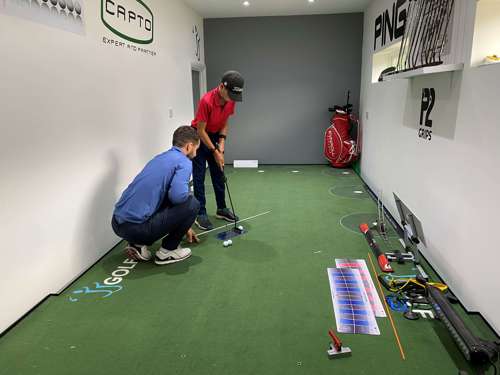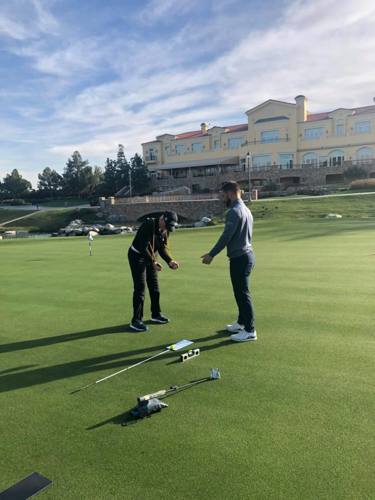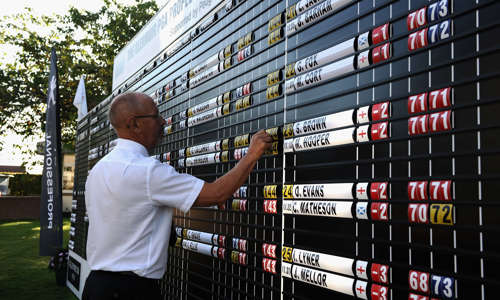How to make 2022 your best putting year yet

22/03/2022
James Jankowski is a specialist putting coach and fitter. In the past three years, he has worked with more than 3,000 golfers, including more than 200 professionals.
If he was to single out a success, it would be seeing Jamie Rutherford win the EuroPro Tour order of merit. They have been working together for almost three years now.
James Jankowski explains why you should consider a putting lesson.
A lot of golfers understand the idiosyncrasies of their swing and have some understanding of what they should be doing to fix something, but I don’t think they really know with putting. Very few people really practise their putting properly and just kind of go around the putting green, without much intent.
I try and get people in their first session to come in for 90 minutes. I would start with an analysis of their current putting game. This would involve using video analysis, Capto and Quintic data, hitting putts from varying distances and break directions, asking appropriate questions the whole time. My goal in the opening 15-20 minutes of a session is to understand the areas within which the client can find the biggest and fastest gains. I’m not just looking at their technique, I’m looking at their process and routines, asking them about their approach, and more. I want them to paint a whole picture. For example, if someone misses left-to-right putts on the low side, is that down to technique, aim or green reading? There is a lot more to putting than being able to hit a straight eight-footer.

My remit is to make someone better, whether that’s a tour pro who will practise and do the right stuff every day or the weekend golfer who may not be able to make drastic changes or spend a significant amount of time practicing. During my early coaching days I was prone to saying this is how you have to do it, as opposed to now, where I will often focus on the smallest changes to see the biggest gains.
People have poor understanding of the concept of how they control speed, that’s the most common technical thing that I see. It’s a bit of a generalisation but most often it’s caused by a lack of acceleration in the backstroke and transition. Speed is then gathered close to impact. There are many drills to help golfers with this and my goal is to find the most suitable one for the individual.
Line is a little bit over-hyped, if I could be good at one element of putting it would be speed as that makes it much easier to be good at everything else.
With green reading a lot of us read putts in a way where we’re not really learning from previous putts and we’re not picturing the curve. The ‘two cups outside’ method is often not the best way to see a putt and commonly leads to an under-read putt.
Green reading varies from person to person, I like to look at it from all angles. Generally you see a slope better from the bottom of the slope, so if it’s an uphill putt, have a look from behind the ball and if it’s downhill from behind the hole. When looking at it from the side, look from the low side.

A ghost hole is a very underused training aid, in my opinion. So many people are poor at picturing the curve (or don't do it at all) and understanding the reality of the ball's path. Many also struggle to understand how to practise green reading. By placing a ghost hole on your line two thirds of the way to the hole (there's a strong commonality at this point) you will get immediate feedback for whether that read is correct and whether you’ve started it on the right line. It will go some way to improving your green reading.
Students learn best when the lesson is tailored to their individual needs and learning styles. What is their skill level? How much do they practice? What facilities are available to them? Are they a visual learner or should I use biofeedback? Do they understand technical language, or should things be kept simple?
As teenagers we did what we did instinctively. Then we see and hear things and get coached out of things and over-complicate it, like lining up every putt, over-reading putts and we get a bit confused. It's all about understanding the processes that work best for you.
Keep note of your putting. A great app is Spider Putt where you can plot every putt that you hit and the break direction and, over time, it shows you Strokes Gained from distance or certain directions and where you tend to miss them. I get most of my players to use this. Just counting the number of putts that you hit is a difficult one as that’s a reflection of your approach play proximity and short game and not just your putting.
- Categories:
- The PGA



































